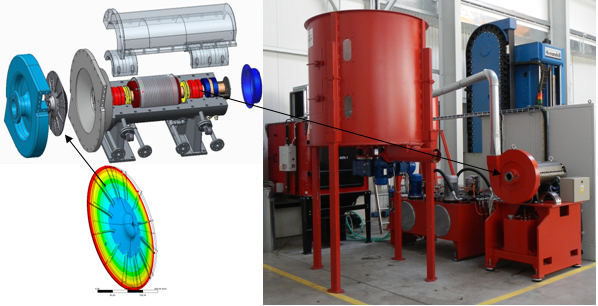| Search for content and authors |
Development of disperse system nanoprocesses using a new supersonic rotor mill |
| Zbigniew Najzarek 1, Remigiusz Petrich , Janusz Wełnowski 2 |
|
1. Opole University, Independent Department of Process Engineering (KIP), Dmowskiego 7-9, Opole 45-365, Poland |
| Abstract |
Micro- and nano-disperse systems , particularly aerosols, liquid and solid suspensions, would help increase the added value of end products in many industrial sectors or, on the other hand, they may increase the adverse environmental impact with human health risk. The above effects, beneficial and harmful, reach a maximum in the disperse system processes involving nanoparticulate reagents. Currently, processes involving these nano-disperse systems are carried out intensively and extensively. The nanomilling process has been proven to be a robust technique for generating and processing of nanoparticle suspensions and emulsions. 
The high speed rotor mill with supersonic capability from Hydrapress Engineering However at present, all the known method for preparation of micro- and nanodisperse systems, including the above nanomilling, are limited in terms of applicability, Additionally, they are very slow, complex, and consume large amount of energy, because they use devices, e.g. the known mills, ineffective for the processes at the nanoscale. In addition, such milling changes the structure and hence properties of the nano-reactants in an uncontrolled manner. In our previous work, a new high-speed centrifugal mill was presented, which efficiently deagglomerate nanomaterials such as carbon black and micro silica, up to primary nanoparticles [1]. Consequently, the purpose of this work was to develop the micro- and nanodisperse systems by the nanomilling process using the new high speed rotor mill with supersonic capability (Figure) [2]. As a result, the mill was adjusted to the function of a new disperse system generator capable to developing the disperse systems from a variety of materials. Thus, the mill can be used to production reactive dispersions for green synthesis of nanomaterials. Moreover, the mill can be used for generating aerosol standards for performance testing of nanoparticulate control devices. Advantages of the present nanomilling technique in relation to the state of the art lies in the fact that it is at least 1000 times faster, energy efficient, simple, and waste-free. Presented mill and method of nanomilling have no equivalent in the state of the art. Using this method, one may receive composite nanomaterials as membranes, catalysts, fuel, pharmaceuticals and cosmetics, as well as lead research towards reducing emission of diesel engines and power plants. References [1] Z. Najzarek, Proc. IX Konrf. Technologie bezodpadowe, Międzyzdroje, 385. [2] H. Holka, J. Wełnowski, Inżynieria i Aparatura Chemiczna 51 (2012) 53 |
| Auxiliary resources (full texts, presentations, posters, etc.) |
|
| Legal notice |
|
| Related papers |
Presentation: Oral at Nano PL 2014, Symposium A, by Zbigniew NajzarekSee On-line Journal of Nano PL 2014 Submitted: 2014-06-30 04:24 Revised: 2014-10-07 15:37 |